Today’s hap is a particular pleasure for me to introduce, as it was created by my dear friend, Tom van Deijnen (aka Tom of Holland), using my own Buachaille yarn. Tom’s hexagonal, modular Hexa Hap is just so very him. Spinning the customary borders-centre construction of Shetland haps in a completely new direction, it combines technical innovation with the familiar feel of classic knitwear design. The Hexa Hap also speaks of the curiosity that impels its maker’s creative process, and is completely full of fun and joy. I just love everything Tom does, and spoke to him recently about the process of creating the Hexa Hap.
KD One of the many things I enjoy about your work is the way you use the deeply technical aspects of fabric creation or manipulation to produce really innovative designs. Can you tell us about how Cecelia Campochiaro’s Sequence Knitting inspired your Hexa Hap?
ToH Campochiaro’s book on Sequence Knitting, which described very simple methods to create complex textured fabrics, is a ground-breaking work. The book is littered with many beautiful photographs: although every method is illustrated with swatches in grey yarn, sequence knitting lends itself well for using colour, as evidenced by many of the projects in the book. However, that’s not what I wanted to concentrate on with the Hexa Hap. What struck me is that all of the stitch patterns are reversible in some way: some are identical on both right side and wrong side, others are just aesthetically reversible (right side and wrong side are completely different, but both present a pleasing texture), some fall in between. I found this reversibility a very attractive quality for a shawl as you can wear it every which way; preserving this reversibility was the main driver for the techniques and patterns I’ve used. This goes for the lace edging (Campochiaro’s Sequence Knitting is knits and purls only) and the reversible intarsia twist technique I “unvented.” In addition, some of the sequence techniques involve decreasing at the end of every row, creating triangles, and this led me to brush off my books on modular knitting. . .
KD Can you tell us a little about the process of designing your Hexa Hap? Where did you begin? Did everything turn out the way that you expected, or were there any surprises?
ToH The idea for a modular shawl or blanket (originally without lace edging) came to me soon after seeing the triangular swatches in Sequence Knitting. Not being a shawl wearer myself, and not in need of yet another blanket, I squirreled away the idea. But every time I opened Sequence Knitting, the idea developed a bit further in my head. So by the time you asked me to contribute to your own book, I had an almost fully formed design in my head. It was then a question of finding the right stitch pattern for the lace edging, and working out some of the reversibility challenges. Swatching soon confirmed that my ideas would work, and the only real surprise for me was the swirl that gets formed in the centre of the shawl. I had expected to have straight lines separating the triangles. The only thing I wasn’t sure about was the lace edging, which I wanted to be in a different colour from the centre. I tried out a few things before settling on the intarsia technique and knit the whole thing in one go. Again, the driver here was reversibility. Picking up stitches along the edge of the centre, or knitting on an edge, wasn’t quite so reversible in a DK weight yarn.
KD Your pattern includes options to knit full, half or 2/3 hexa haps, because of the design’s modular construction. Can you explain a little more about this?
ToH The Hexa Hap is constructed by knitting a triangle with a lace edging on one of its edges. When the first triangle is complete, you pick up stitches along another edge, and knit another triangle. You continue adding more triangles until you have three, four, or six triangles. The Half Hexa Hap and the 2/3 Hexa Hap are quite easy to finish, as they require a knitted on i-cord edging. The full-sized Hexa Hap has a sting in its tail, as there is a seam to be closed, attaching the selvedge of the last triangle to the base of the first one. In order to preserve the reversibility, the seam is grafted closed in pattern. Once this is completed, it has proven to be rather difficult to work out the construction of the shawl, and some of the people who have seen it assumed it was knitted from the centre outwards on circular needles. I first came across the technique I’ve used for grafting in pattern on Fleegle’s blog . In her blog post she describes how she uses waste yarn to knit the row that will be grafted. The waste yarn will be removed once the grafting is finished. Despite my large reference library, Fleegle’s blog is all I could find about it, so I’ve made a video tutorial to help knitters along the way, in case the written instructions require some additional illustration. (Note that this video tutorial illustrates grafting in pattern in the context of the Hexa Hap design only!)
KD your reversible intarsia twist is a technique that you’ve “unvented” for this design. Can you describe what it involves and why its useful for this design?
ToH With intarsia you twist the two colours around each other at the “seam” and with regular intarsia this shows on the wrong side of the work. As I was hell-bent on keeping the Hexa Hap completely reversible, I played around with the intarsia technique until I came up with something that would make it look the same on both sides. It’s a very simple variation, where you cross the old colour underneath the new colour, and then bring the old colour between the needles to the front of the work. The yarns now twist around each other inside the fabric, so to speak, rather than at the back.
KD I think there is something fundamentally pleasing about hexagonal shapes, and I love naturally occurring hexagon patterns from bees honeycomb to tortoise shells. Do you feel a similar hexagonal affinity? And do you enjoy exploring the structure of other geometric shapes in your knitting and other work?
ToH Hexagonal affinity; what a great term! I don’t think I have a particular affinity with hexagonal shapes, but I do like geometry and repetitions in general. In particular I like it when repetitions go slightly askew. So to have the swirl appear in the shawl is, to me, a beautiful coincidence. In addition, I’m interested in texture, another reason why I find Campochiaro’s book so stimulating.
KD I really enjoyed styling and modelling your hexa hap, and found it very wearable, in much the same manner as a Shetland hap. Like a Shetland hap, I also think it would make a wonderful blanket for a baby. I also found myself wearing one of the mini-hexa haps you made as a kerchief to keep my neck warm when I was helping Tom out on our Shetland photoshoots. It’s such a versatile design! I love the sample so much I don’t really want to send it back, but I wondered how you intended to wear or use it when I did?
ToH Thank you very much, I’m so pleased to hear you like it so much! As I don’t wear shawls myself, it was a bit of a leap of faith to design one. I could see myself wearing a mini half Hexa Hap as a kerchief (thanks for the idea), but the full-sized one I would use as a blanket. There’s nothing more I enjoy of a winter’s evening than to cuddle up under a warm woolly blanket.
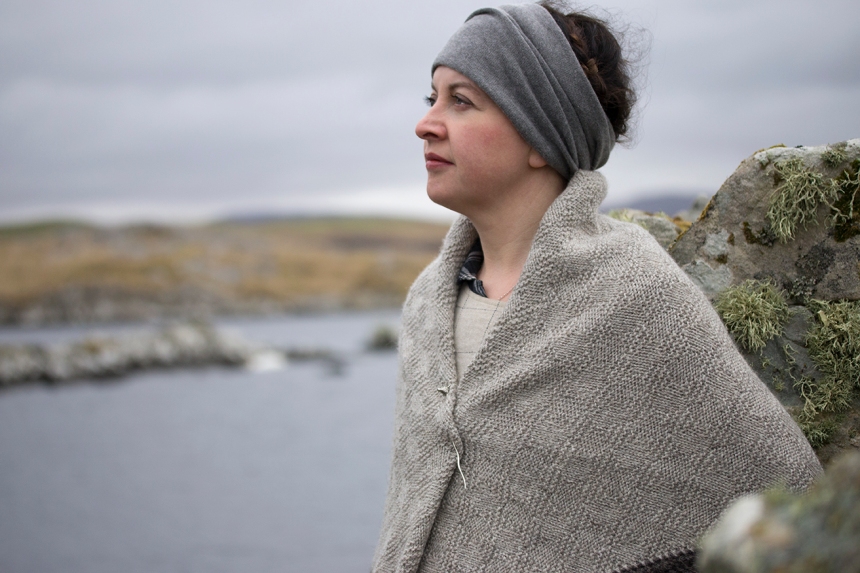
KD yes, I think it would make a wonderful baby blanket or lap blanket – and I was very hap-py to be happed up in it!
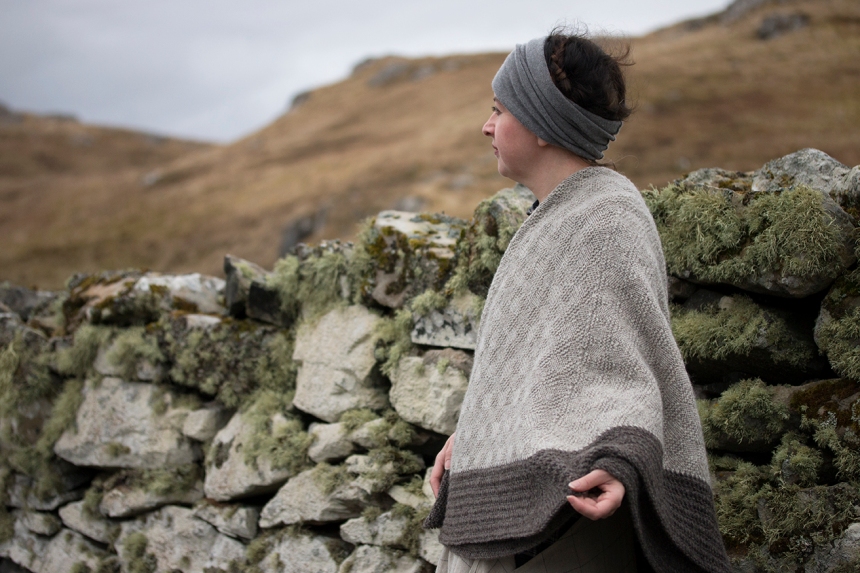
These photographs were taken at Da Brigs near Vementry in Shetland – a very special place.
Thankyou so much, Tom, for creating your fabulously innovative Hexa Hap!
The Book of Haps is now available to pre-order. You can see all of the designs as they appear each day on Ravelry and be sure to pop over to Jen’s blog tomorrow when the next hap will be revealed!


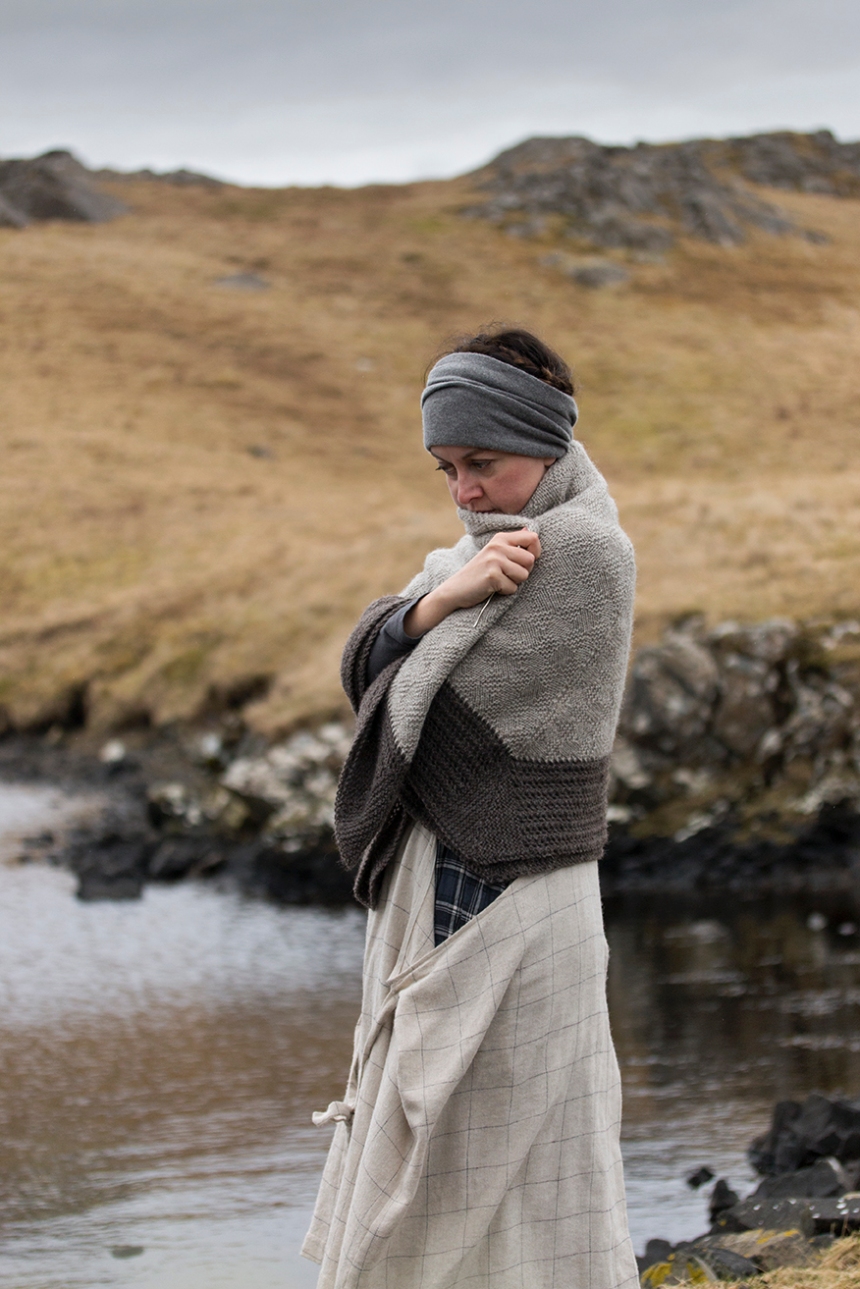
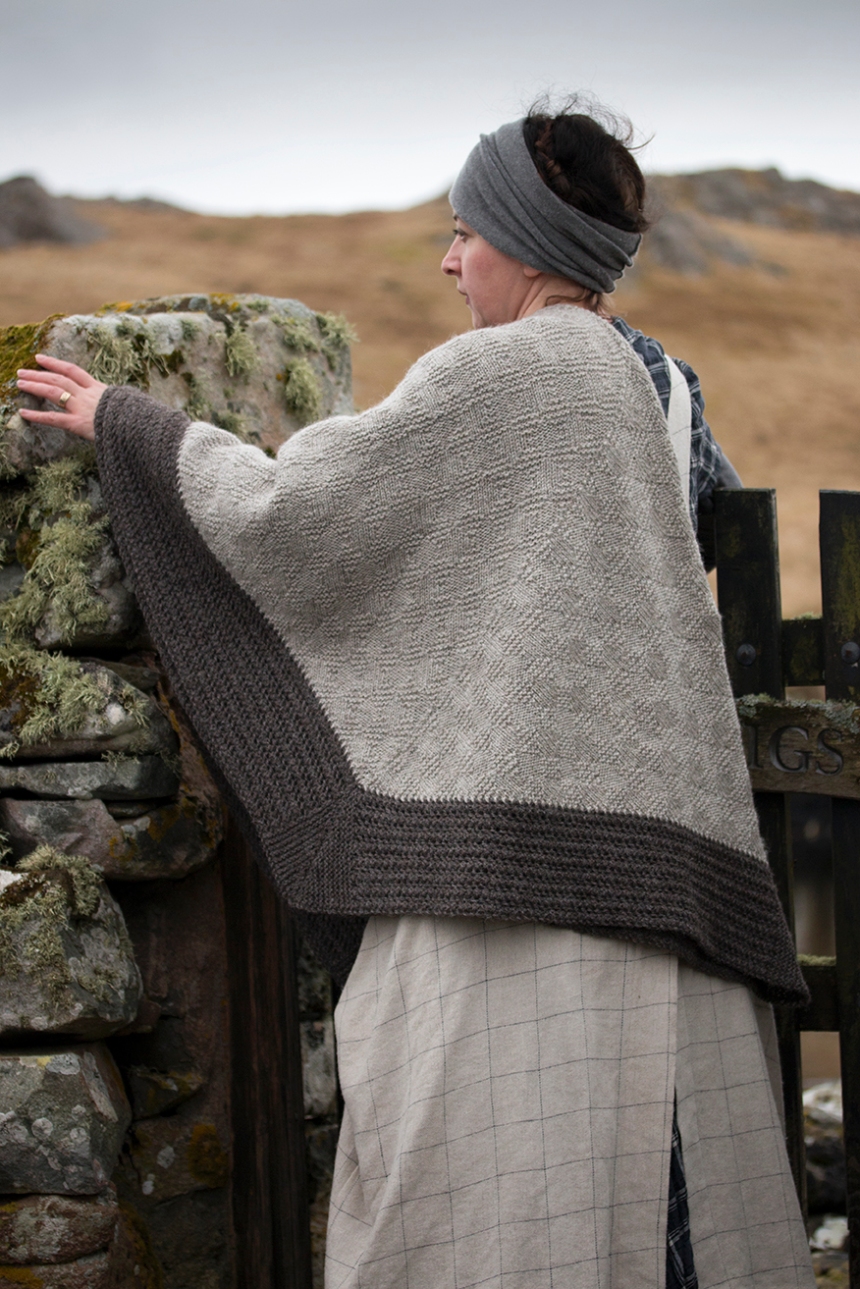

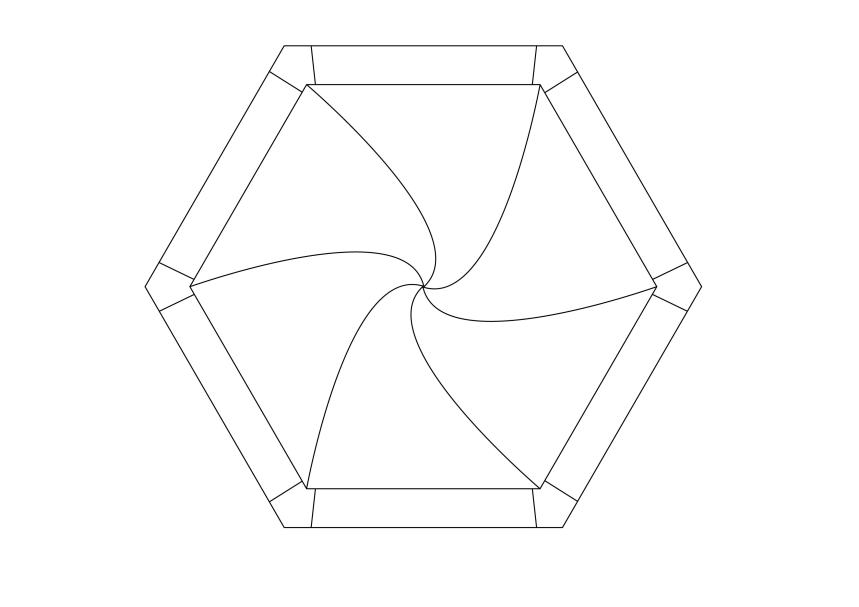


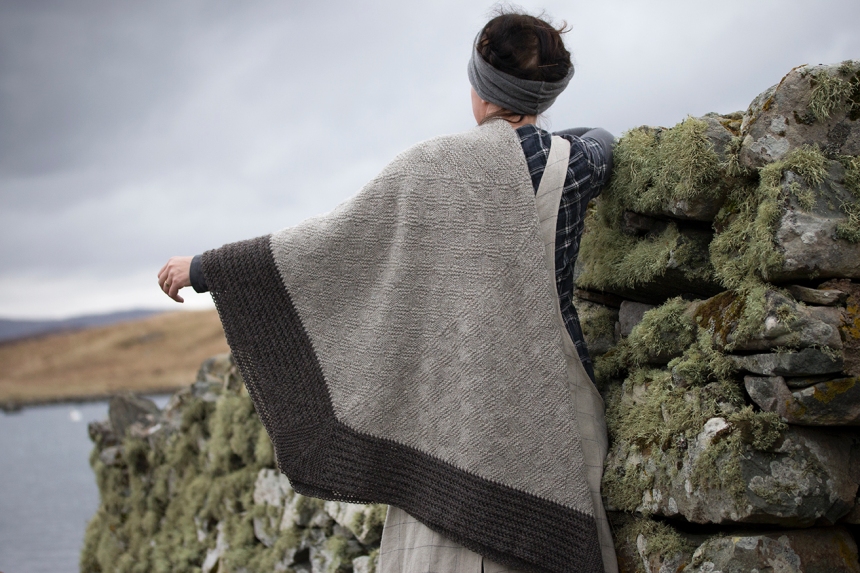
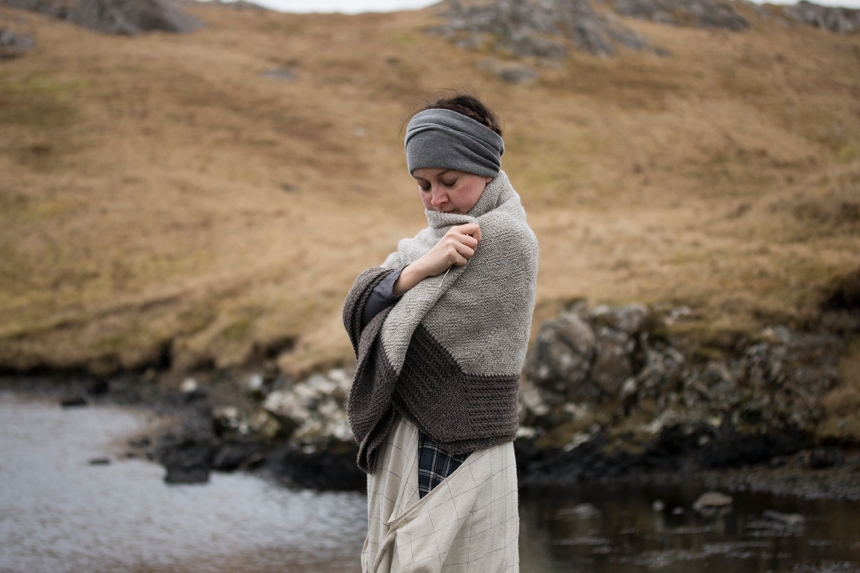

Well, this is the design that did it … I have ordered my copy of the book. Goodness knows how I managed to hold out for so long. Each wonderful design has been so tempting, but this is the one that tipped me over the edge. My Seven Skeins club yarn is still sitting nearby and enables me to feel the texture of this shawl. I am also thinking about knitting each hex section in a different colour of Buachaille and the edging in the dark grey. The video tutorial for the grafting of the whole hap is quite intriguing and well done. So looking forward to receiving my copy of the book. Well done!
LikeLike
Love the color, texture, construction! Wondering if the mini-hexa will be available as a pattern?
LikeLike
Love this one for the texture element. Now I am thinking that this one may be the first one I make although I have never done intarsia. Love the swirl part as well.
LikeLike
I love the design. It’s such a lovely shawl.
LikeLike
Spectacular!!! And Buachaille and Tom of Holland are a match made in heaven. Yes, it will be for my yet-to-be-born next grandchild.
Was wondering, does the kerchief consist of 1 of the triangles?. It would be lovely to have the pleasure of knitting this pattern for a friend without the time commitment of the hap. If not, will the pattern for it be available separately
Anyway, another glorious book. Thanks Kate and Co.. robin warren
LikeLike
oh yes, this is definitely the first one to knit! I love the way the texture and look of the wool changes as you look at the stitching from different directions- reminds me of damask. Beautiful neutral colours as well.
Can I second or third the question about the lovely pinafore dress?
LikeLike
Very clever. I would Never have been able to figure this one out!! Love the colours.
LikeLike
All the shawls so far are lovely, but I think this will be my first knit…now I have to decide on yarn…and, can you tell us about the dress the model is wearing? what a great combo…
LikeLike
I am in love with the textures you created, Tom! And the way the light plays off of the stitches done with your yarn, Kate. Just beautiful.
LikeLike
Love this design! I am intrigued by the construction…maybe I could get a hap going after the summer heat abates!
LikeLike
Gorgeous. I’m wondering if you were modeling a 1/2 or a full Hexa? Or both at different times? The construction is extremely intriguing, and I appreciate the interview with Tom on his design inspirations and resources. Great interview and design, thanks!!!
LikeLike
I’m wearing the full Hexa Hap – folded in half in some photos.
LikeLike
Apart from this intriguing design, I just love the photography! And the stunning scenery of course. :)
LikeLike
Spectacular.
LikeLike
Love love love it! I’m completely taken in by the textures and the techniques- cannot wait for this one!!
LikeLike
I love this one! And the video was great. Tom made it look so easy….do you think he would come to my house to help me do it?
LikeLike
I would NOT have sent that hap back! The color combination is gorgeous. I have some baby knitting to do, but I ear if I need this, I wouldn’t be able to give it up. ;). Perfect choice of colours, Tom, and I’m intrigued by your intarsia unvention.
LikeLike
Such a superb design! And I think it looks so beautiful in your natural-colored yarn.
LikeLike
Living in Australia, winter coming on and the days getting shorter it has been a pleasure receiving daily updates. Love your work team
LikeLike
This is lovely and looks extremely warm and envelopping! Like everyone else leaving comments, I would love to knit them all. Am so looking forward to getting the book!
LikeLike
this is clever! and will be such an interesting knit
LikeLike
That’s really nice, though I think I’d be tempted to see if I could knit it centre-out. Like a giant tam!
LikeLike
Love the colour & the design!
LikeLike
Each of the previous shawls has been beautiful in its own way and I want to make them all, but this was the first design to leap out at me and say “Yes! Me!” I will wait impatiently till the book arrives…. (Good motivation to finish other things first!)
LikeLike
Truly beautiful!
LikeLike
such a gorgeous project! I am also taken by your adorable pinafore…did you make it?
LikeLike
Whetting my anticipation – everyday! Yum yum – looking forward to my copy. /: ).
LikeLike
so I did it, I pre-ordered your fabulous book.
can’t wait to get it.
thanks for creating so beautiful knitting pattern :-)
LikeLike
These posts are stunning – thank you
LikeLike
I need to by your book – that’s for sure.
so great pattern.
:-)
LikeLike
Oh no! The 4th one I want to knit, where can I by extra hours ????
Thank you Kate for this lovely project! Can’t wait to hold your book in my hands…
LikeLike